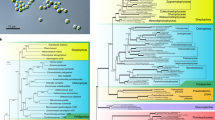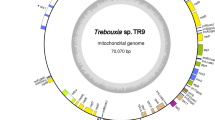Abstract
It is generally accepted that chloroplasts arose from one or more endosymbiotic events between an ancestral cyanobacterium and a eukaryote1. Such an origin fits well in the case of the chloroplasts of rhodophytes that, like cyanobacteria, contain chlorophyll a and phycobilin pigments2. The green chloroplasts from higher plants, green algae, and euglenoids however, contain chlorophyll b as well as chlorophyll a, and lack phycobilins. Consequently, it has been suggested that they arose independently of the rhodophyte chloroplasts, from an ancestral prokaryote containing that complement of pigments3. The 'prochlorophytes'Prochloron didemni (an exosymbiont on didemnid ascidians4,5) and Prochlorothrix hollandica(a recently discovered, free-living, filamentous form6) have been suggested to be modern counterparts of the ancestor of the green chloroplasts because they are prokaryotes that also contain both chlorophylls a and ft, and lack phycobilins7,8. We report here a 16S rRNA-based phylogenetic analysis of P. hollandica. The organism is found to fall within the cyanobacterial line of descent, as do the green chloroplasts, but it is not a specific relative of green chloroplasts. Thus, similar pigment compositions do not necessarily reflect close evolutionary relationships.
This is a preview of subscription content, access via your institution
Access options
Subscribe to this journal
Receive 51 print issues and online access
$199.00 per year
only $3.90 per issue
Buy this article
- Purchase on Springer Link
- Instant access to full article PDF
Prices may be subject to local taxes which are calculated during checkout
Similar content being viewed by others
References
Gray, M. W. & Doolittle, W. F. Microbiol. Rev. 46, 1–42 (1982).
Lee, R. E Phycology, 288–299 (Cambridge University Press, New York, 1980).
Raven, P. H. Science 169, 641–646 (1970).
Newcomb, E. H. & Pugh, T. D. Nature 253, 533–534 (1975).
Lewin, R. A. & Cheng, L. Phycologia 14, 149–152 (1975).
Burger-Wiersma, T., Veenhuis, M., Korthals, H. J., Van de Wiel, C. C. M. & Mur, L. R. Nature 320, 262–264 (1986).
Lewin, R. A. & Withers, N. W. Nature 256, 735–737 (1975).
Thorne, S. W., Newcomb, E. H. & Osmond, C. B. Proc. natn. Acad. Sci. U.S.A. 74, 575–578 (1977).
Seewaldt, E. & Stackebrandt, E. Nature 295, 618–620 (1982).
Stackebrandt, E., Seewaldt, E., Fowler, V. J. & Schleifer, K. H. Arch. Mikrobiol. 132, 216–217 (1982).
Van Valen, L. M. Nature 298, 493–494 (1982).
Patterson, G. M. L. & Withers, N. W. Science 217, 1034–1035 (1982).
Giovannoni, S. J. et al. J. Bacteriol. 170, 3584–3592 (1988).
Gutell, R. R., Weiser, B., Woese, C. R. & Noller, H. F. Prog. Nucleic Acid Res. Molec. Biol. 32, 155–216 (1985).
Bonen, L. & Doolittle, W. F. Proc. natn. Acad. Sci. U.S.A. 72, 2310–2314 (1975).
Golding, G. B. Molec. biol. Evol. 1, 125–142 (1983).
Olsen, G. J. Cold Spring Harbor Symp. quant. Biol. 52, 829–837 (1987).
Felsenstein, J. Evolution 39, 783–791 (1985).
Hall, W. T. & Claus, G. J. Cell Biol. 19, 551–563 (1963).
Herdman, M. & Stanier, R. Y. FEMS Lett. 1, 7–12 (1977).
Loffelhardt, W. et al. Ann. N.Y. Acad. Sci. 503, 550–552 (1987).
Schenk, H. E. A., Bayer, M. G. & Zook, D. Ann. N.Y. Acad. Sci. 503, 151–167 (1987).
Ashlock, P. D. Syst. Zool. 28, 441–450 (1979).
Lewin, R. A. Nature 261, 697–698 (1976).
Antia, N. J. Br. phycol. J. 12, 271–276 (1977).
Rippka, R., Deruelles, J., Waterbury, J. B., Herdman, M. & Stanier, R. Y. J. gen. Microbiol. 111, 1–61 (1979).
Lane, D. J., Field, K. G., Olsen, G. J. & Pace, N. R. Meth. Enzym. 167, 138–144 (1988).
Olsen, G. J. Meth. Enzym. 164, 793–812 (1988).
Author information
Authors and Affiliations
Rights and permissions
About this article
Cite this article
Turner, S., Burger-Wiersma, T., Giovannoni, S. et al. The relationship of a prochlorophyte Prochlorothrix hollandicato green chloroplasts. Nature 337, 380–382 (1989). https://doi.org/10.1038/337380a0
Received:
Accepted:
Issue Date:
DOI: https://doi.org/10.1038/337380a0
This article is cited by
-
Draft genome of Prochlorothrix hollandica CCAP 1490/1T (CALU1027), the chlorophyll a/b-containing filamentous cyanobacterium
Standards in Genomic Sciences (2016)
-
Population Dynamics and Diversity of Viruses, Bacteria and Phytoplankton in a Shallow Eutrophic Lake
Microbial Ecology (2008)
Comments
By submitting a comment you agree to abide by our Terms and Community Guidelines. If you find something abusive or that does not comply with our terms or guidelines please flag it as inappropriate.



